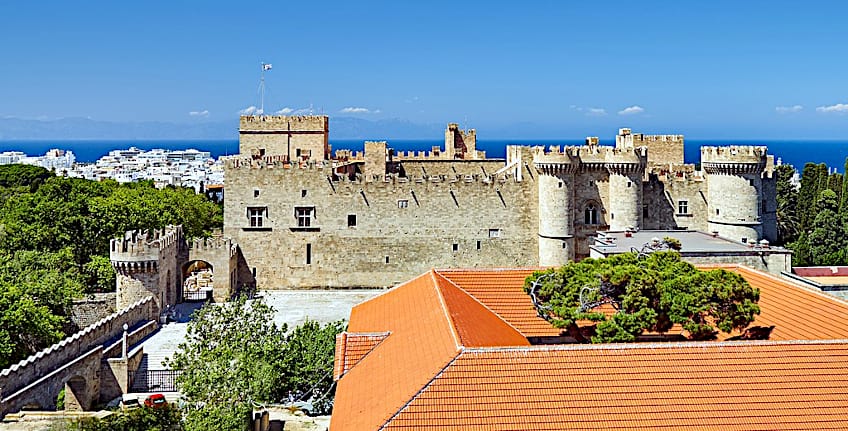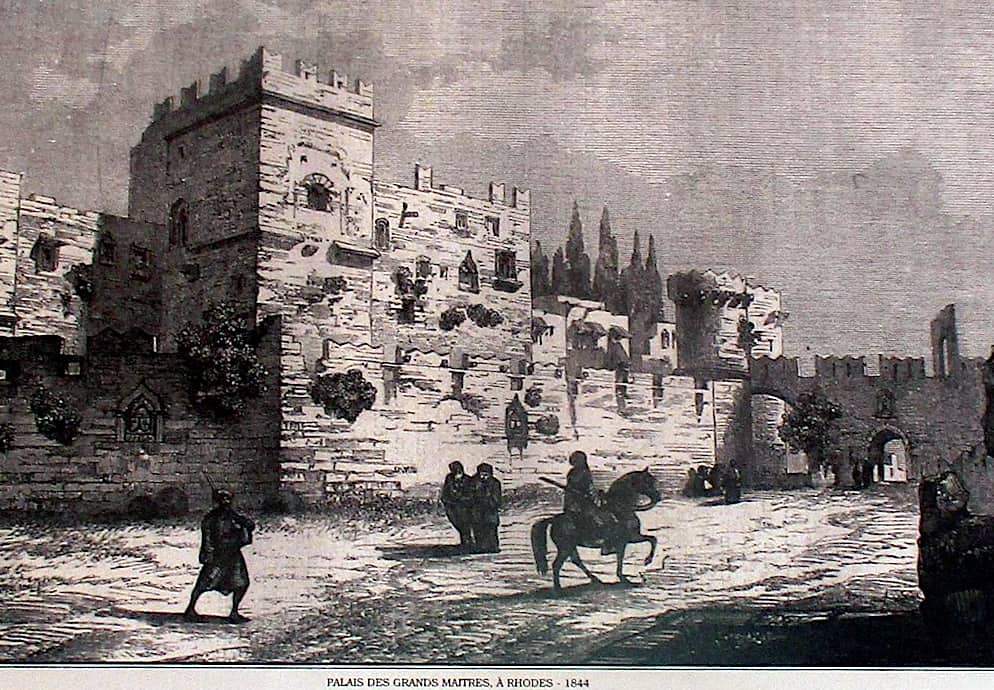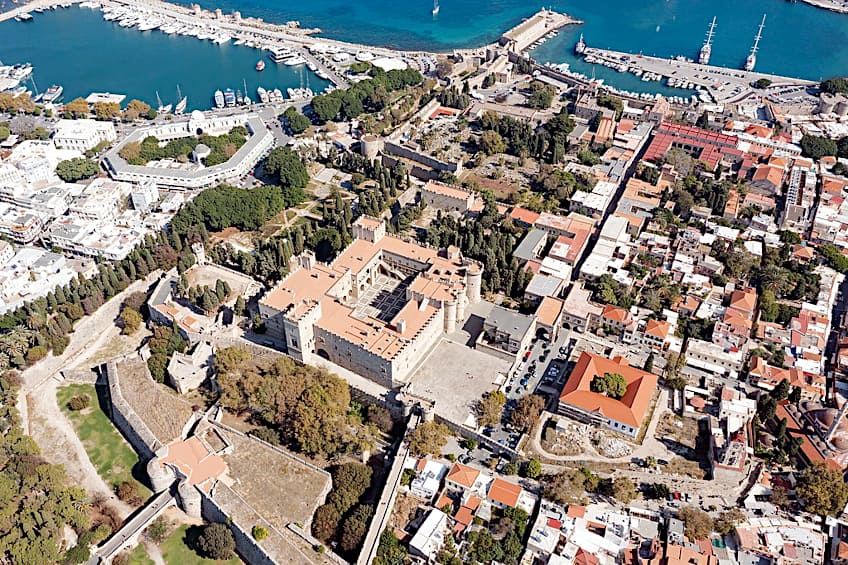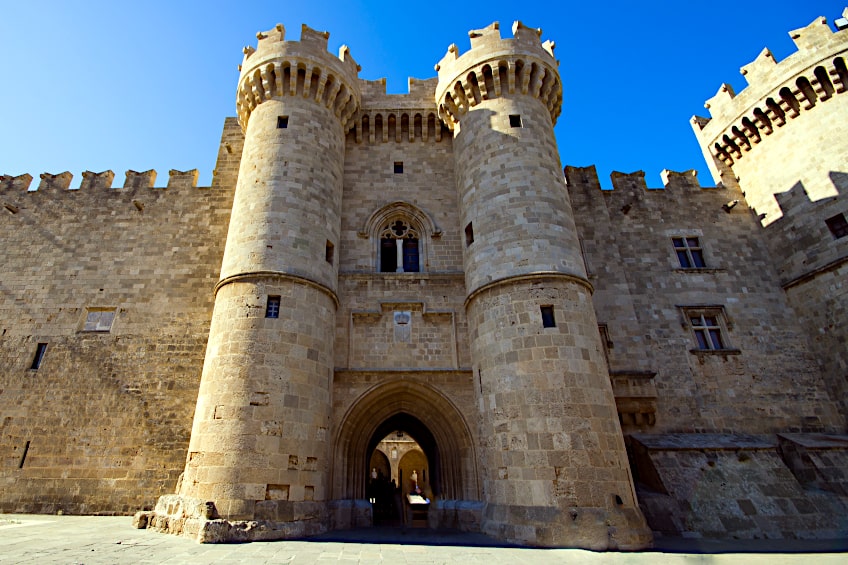Grand Master Palace Rhodes- The Knights of Rhodes’ Kastello
At the top of the historic city of Rhodes stands a fortress called the Palace of the Grand Master of Rhodes. The Grand Master Palace of Rhodes, which was first constructed as a stronghold by the Knights of Rhodes, was crucial to the region’s defense all through history. Today, tourists may explore the castle of Rhodes, taking in the museum treasures stored inside and viewing elements of the building constructed in various eras.
The Palace of the Grand Master of Rhodes
| Architect | Knights Hospitaller (c. 7th century) |
| Date Completed | c. 7th century |
| Function | Castle |
| Location | Rhodes, Greece |
This historical place has been documented since antiquity. Prior to the construction of the palace, the location was home to the ancient temple of Helios, the Sun god. Helios was classified as a minor god in Classical Greece, but he rose to prominence in late antiquity and was elevated to the status of a major figure by Emperor Julian.
The sanctuary eventually fell into ruin, and in the late 7th century, the Byzantine empire erected a castle on its remains.

History of the Castle of Rhodes
The Knights Hospitaller seized Rhodes as well as other Greek islands in the 14th century. The Knights Hospitaller was a Catholic order that was founded to care for ill or impoverished travelers in the Holy Land. Following the First Crusade, the knights became increasingly military in nature, focusing on the care and defense of the Holy Land. When Islamic armies seized the Holy Land, the Knights Hospitaller established a base on Rhodes.

The Knights of Rhodes restored and extensively altered the 7th-century Byzantine stronghold, transforming it into an administrative headquarters and a home for their order’s Grand Master.
They also constructed a number of additional strongholds and defenses on the Greek island of Rhodes. After being damaged in the 1481 Rhodes earthquake, which killed approximately 30,000 people, the palace had to be rebuilt. The Ottoman Empire conquered the island of Rhodes in 1522. Despite the fact that they besieged the castle, they did not cause major damage to it. Following their conquest, the Ottomans transformed the palace into a command headquarters and fortress, even utilizing it as a jail.
For over 400 years, the Ottomans ruled over the island of Rhodes. When lightning hit munitions kept in the neighboring Church of St. John, it nearly destroyed the castle of Rhodes. It lay in ruins until Italy invaded the region during the Italo-Turkish war.

During the Italian occupation of Rhodes, architect Vittorio Mesturino restored the Grand Master Palace of Rhodes and rebuilt what had been damaged using blueprints of the original structure. The castle of Rhodes then served as a vacation home for Italian King Victor Emmanuel III and, subsequently, fascist dictator Benito Mussolini. As part of the post-World War II settlement, Italy handed Rhodes and the remainder of the Dodecanese Islands to Greece in 1948. The Grand Master Palace of Rhodes was transformed into a museum by the Greek government.
Inside the Palace of the Grand Master of Rhodes
The Grand Master Palace of Rhodes is still owned by the Greek government. Tourists can view the castle’s internal courtyard and a section of the chambers for a modest price. You may buy a ticket to only see the palace or a combo ticket that includes admission to surrounding institutions. Visiting hours differ depending on whether it is peak or low season. The castle is a 6,000-square-meter rectangle edifice with stunning spherical towers.
The Palace of the Grand Master of Rhodes, while graceful, is nonetheless a fortress encircled by a triple circuit of walls. Cannons are still on exhibit in the bastion on the western edge of the palace.

Visitors will first see the huge courtyard after entering through a big arched entryway on the south wall. The courtyard is coated with beautiful stone and bordered with shaded arcades rather than grass. It also exhibits Greco-Roman statues discovered during the excavation of the Odeon of Kos. Inside the castle, tourists may experience gorgeous staircases and spectacular halls displaying historical relic collections. The Grand Reception Hall, the Chamber of Colonnades, the Chamber of the Nine Muses, and the Music Room are just a few of the exquisite chambers inside the castle of Rhodes. The Grand Master’s private apartments may also be seen.
The Italians erected a simple chapel near the great stairway to the palace in the 20th century. Collections of early modern weaponry, literature, gems, and art may be found in several parts of the castle.
Beautifully carved furniture, medieval clothing, and hand-woven textiles are among the other exhibits on show. The floors of the structure are adorned with ancient mosaics, along with a renowned portrayal of Medusa from the 2nd century BCE. These mosaics were transported in from Kos Island and are not native to the castle. The castle has drawn millions of visitors since it became a museum in the mid-20th century, and it even held a summit of the European Economic Community in 1988, and it is also designated as a UNESCO World Heritage Site.

This enormous structure served as the Grand Master’s residence as well as the Order’s major administrative headquarters and the island’s social and cultural hub. The most significant halls were on the first level, as were the Grand Master’s private chambers. The Palace was crucial in the ancient fortification of the northern portion of Rhodes’ walled city. Following the Ottoman takeover of Rhodes in 1522, the structure lost its significance and was mostly utilized as a jail. Several earthquakes gradually weakened the structure until, in 1865, a horrific explosion in the adjoining basement of the church of St. John, which the Ottomans used as an armory, destroyed it. The first level fell completely, and only a little portion of it remained until 1937 when restoration efforts began.
Frequently Asked Questions
What Does the Castle of Rhodes Look Like?
The castle of Rhodes’s structure is rectangular in design and positioned around a central courtyard. The primary entryway to the central open courtyard is located on the south side. The Grand Master’s Palace now serves as a museum as well as an exhibition space. The bottom level houses two permanent displays about the ancient city of Rhodes, whereas the first floor houses the rebuilt majestic halls of the Castle of Rhodes as well as the impressive Hellenistic floor mosaics from Kos that were relocated there during the Italian reconstruction to decorate the area.
Who Were the Knights of Rhodes?
The famed city of Rhodes has a very fascinating past, and the Knights of Rhodes who had formerly lived here have left an unforgettable impact on the region and its people. The narrative of the Knights of Rhodes who came to dwell in the area began in the 11th century, with the establishment of a holy military order in Jerusalem. The Hospitallers, as the organization was originally known, was a monastic group of knights who functioned under a Grand Master appointed for life. In addition, the society to which the knights served still exists to this very day, with a Grand Master and everything, implying that there is a small set of people in our world who still get to write Knight on their official forms.
Justin van Huyssteen is a freelance writer, novelist, and academic originally from Cape Town, South Africa. At present, he has a bachelor’s degree in English and literary theory and an honor’s degree in literary theory. He is currently working towards his master’s degree in literary theory with a focus on animal studies, critical theory, and semiotics within literature. As a novelist and freelancer, he often writes under the pen name L.C. Lupus.
Justin’s preferred literary movements include modern and postmodern literature with literary fiction and genre fiction like sci-fi, post-apocalyptic, and horror being of particular interest. His academia extends to his interest in prose and narratology. He enjoys analyzing a variety of mediums through a literary lens, such as graphic novels, film, and video games.
Justin is working for artincontext.org as an author and content writer since 2022. He is responsible for all blog posts about architecture, literature and poetry.
Learn more about Justin van Huyssteen and the Art in Context Team.
Cite this Article
Justin, van Huyssteen, “Grand Master Palace Rhodes- The Knights of Rhodes’ Kastello.” Art in Context. June 29, 2023. URL: https://artincontext.org/grand-master-palace-rhodes/
van Huyssteen, J. (2023, 29 June). Grand Master Palace Rhodes- The Knights of Rhodes’ Kastello. Art in Context. https://artincontext.org/grand-master-palace-rhodes/
van Huyssteen, Justin. “Grand Master Palace Rhodes- The Knights of Rhodes’ Kastello.” Art in Context, June 29, 2023. https://artincontext.org/grand-master-palace-rhodes/.









